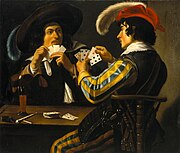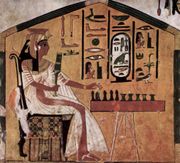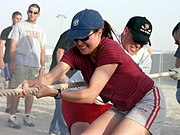
A game is a structured type of play, usually undertaken for entertainment or fun, and sometimes used as an educational tool. Many games are also considered to be work (such as professional players of spectator sports or games) or art (such as jigsaw puzzles or games involving an artistic layout such as Mahjong, solitaire, or some video games).
Games are sometimes played purely for enjoyment, sometimes for achievement or reward as well. They can be played alone, in teams, or online; by amateurs or by professionals. The players may have an audience of non-players, such as when people are entertained by watching a chess championship. On the other hand, players in a game may constitute their own audience as they take their turn to play. Often, part of the entertainment for children playing a game is deciding who is part of their audience and who is a player. A toy and a game are not the same. Toys generally allow for unrestricted play whereas games present rules for the player to follow.
Key components of games are goals, rules, challenge, and interaction. Games generally involve mental or physical stimulation, and often both. Many games help develop practical skills, serve as a form of exercise, or otherwise perform an educational, simulational, or psychological role. (Full article...)

The Wii (/wiː/ WEE) is a home video game console developed and marketed by Nintendo. It was released on November 19, 2006, in North America, and in December 2006 for most other regions of the world. It is Nintendo's fifth major home game console, following the GameCube, and is a seventh-generation console alongside Microsoft's Xbox 360 and Sony's PlayStation 3.
In developing the Wii, Nintendo president Satoru Iwata directed the company to avoid competing with Microsoft and Sony on computational graphics and power and instead to target a broader demographic of players through novel gameplay. Game designers Shigeru Miyamoto and Genyo Takeda led the console's development under the codename Revolution. The primary controller for the Wii is the Wii Remote, a wireless controller with both motion sensing and traditional controls which can be used as a pointing device towards the television screen or for gesture recognition. The Wii was Nintendo's first home console to directly support Internet connectivity, supporting both online games and for digital distribution of games and media applications through the Wii Shop Channel. The Wii also supports wireless connectivity with the Nintendo DS handheld console for selected games. Initial Wii models included full backward compatibility support for GameCube games and most accessories. Later in its lifecycle, two lower-cost Wii models were produced: a revised model with the same design as the original Wii but without the GameCube compatibility features, and the Wii Mini, a compact, budget redesign of the Wii which further removed several features, including online connectivity and SD card storage. (Full article...)
- ...that Tom Hanks was in a 1982 TV movie called Mazes and Monsters about a group of college students and their interest in the eponymous role-playing game?
- ...that the golden age of arcade video games began with the release of Space Invaders in 1978?
- ...that the most famous boardwalk in the United States is probably the one in Atlantic City, New Jersey, thanks to its association with the Monopoly board game?
- ...that Pepsi offered a Harrier fighter jet in their Pepsi Billion Dollar Sweepstakes game and the Pepsi Stuff game?
- ...that 1956 was the first time when a computer was able to play a chess-like game, Los Alamos chess (pictured)?

A Bananagrams case and tiles
The following Wikimedia Foundation sister projects provide more on this subject:
-
Commons
Free media repository -
Wikibooks
Free textbooks and manuals -
Wikidata
Free knowledge base -
Wikinews
Free-content news -
Wikiquote
Collection of quotations -
Wikisource
Free-content library -
Wikiversity
Free learning tools -
Wiktionary
Dictionary and thesaurus


















































